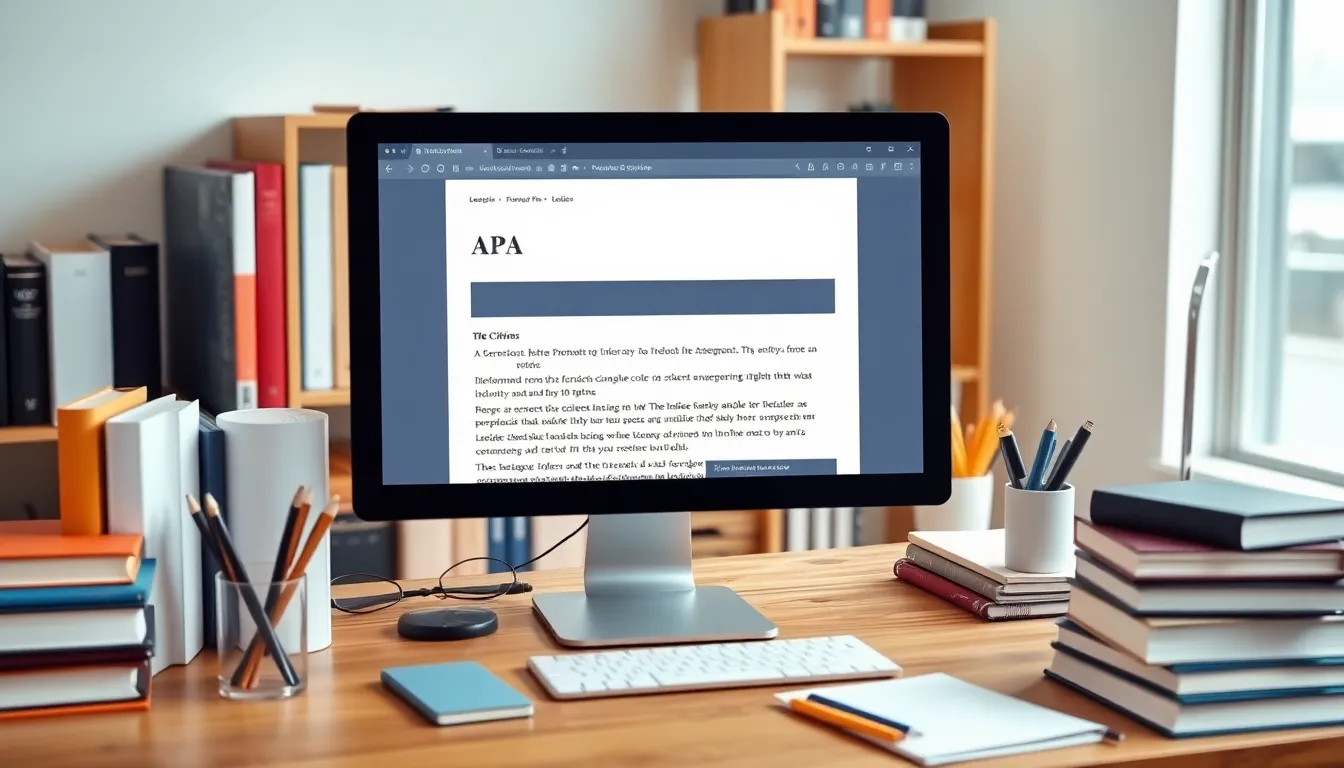Table of Contents
ToggleNavigating the world of citations can feel like trying to find a needle in a haystack—especially when that needle doesn’t have a name or a date. Fear not! When it comes to APA citations for websites with no author and no date, there’s a simple way to keep your references looking sharp and professional.
Understanding APA Citation
Creating APA citations involves specific rules, especially when dealing with sources without authors or dates. A website lacking both elements requires following a distinct format to maintain clarity. The citation should include the title of the webpage, followed by the retrieval date and the URL.
Website titles take precedence when there is no author. They should be italicized in the reference list for easy identification. For example, if a webpage titled “Guide to Healthy Eating” lacks an author, this title becomes the focal point of the citation. The format for such a citation follows this structure:
Title of webpage. (n.d.). Retrieved [Month Day, Year], from [URL]
In this example, “(n.d.)” indicates the absence of a publication date. Retrieval dates are essential for content that may change over time. By including the date of access, the reader knows when the information was verified.
Adding the URL finalizes the citation. When listing URLs, omit “http://” or “https://” to maintain a clean appearance. This succinct approach keeps citations professional while adhering to APA standards.
Organizing references correctly enhances overall clarity in the bibliography. Citing websites without authors and dates might seem challenging, but by following these guidelines, he or she can ensure their citations remain accurate and accessible. These methods provide a solid foundation for anyone facing similar citation dilemmas within academic writing.
The Importance of Citing Sources

Citing sources is crucial for maintaining the integrity of academic work. It provides transparency and allows readers to trace the origin of information.
The Role of Authors and Dates
Authors contribute credibility to sources, representing expertise. Dates indicate when information was published, showing its relevance. These elements enhance the trustworthiness of references in scholarly contexts. When available, they guide readers to understand the context and timeliness of research. Their absence can present challenges, particularly in developing a complete APA citation, but it is not insurmountable.
When There Are No Authors or Dates
Handling sources without authors or dates requires attention to detail. In these cases, the title of the webpage takes precedence. It should be italicized for easy identification, serving as the focal point of the citation. Including a retrieval date becomes essential since the content may change over time. URLs must be presented without “http://” or “https://” for a cleaner look. This approach ensures citations remain informative despite missing traditional elements.
How to Cite a Website with No Author and No Date
Citing a website without an author and date requires specific formatting in APA style. It’s crucial to follow these guidelines for clarity and professionalism.
Format for In-Text Citations
Use the title of the webpage as the in-text citation. For example, if citing “Understanding Quantum Physics,” the citation appears as (“Understanding Quantum Physics,” n.d.). The abbreviation “n.d.” stands for “no date.” Place it in parentheses following the title. Ensure to include quotation marks around the webpage title. This method draws attention to the source while signaling that no author or date is available.
Format for Reference List Entries
Begin the reference list entry with the webpage title, italicized for visibility. Next, add “n.d.” in parentheses to indicate the absence of a publication date. Follow with “Retrieved Month Day, Year, from,” then include the URL. For example, the complete citation appears as follows: Understanding Quantum Physics. (n.d.). Retrieved October 10, 2023, from http://www.example.com. This structure emphasizes transparency and enhances citation integrity.
Examples of APA Citation with No Author and No Date
Citing sources without an author and date requires precise formatting to maintain clarity. The following subsections detail application examples in different contexts.
Citing Different Types of Websites
Citations will differ based on the type of website. For a general webpage, the format begins with the italicized title, followed by “(n.d.)”, the retrieval date, and the URL. For instance, if citing a blog post titled “Understanding Climate Change”, it appears as follows:
Understanding Climate Change. (n.d.). Retrieved October 10, 2023, from www.example.com
In the case of a news article, use the same format. An example for “Global Economic Trends” may look like:
Global Economic Trends. (n.d.). Retrieved October 10, 2023, from www.example.com
This structure helps ensure readers can trace the information effectively.
Common Mistakes to Avoid
Certain pitfalls can affect citation quality. Forgetting to italicize the title leads to inconsistent formatting. Additionally, omitting the retrieval date can create uncertainty about content stability. Neglecting to include “n.d.” often results in incomplete information.
Avoid using “http://” or “https://” when presenting URLs. This practice keeps citations neat and clear. Always double-check the accuracy of URLs to ensure valid links. Prioritize clarity and consistency to enhance the professionalism of citations.
Navigating the world of citations can be tricky especially when dealing with sources that lack both authors and dates. By following the structured guidelines for APA citations outlined in this article, anyone can maintain clarity and professionalism in their references. Emphasizing the title of the webpage and including retrieval dates ensures that citations remain transparent and credible.
Adhering to these best practices not only enhances the integrity of academic work but also allows readers to easily trace information. With careful attention to detail and consistent formatting, citations can effectively support the arguments and insights presented in any piece of writing.